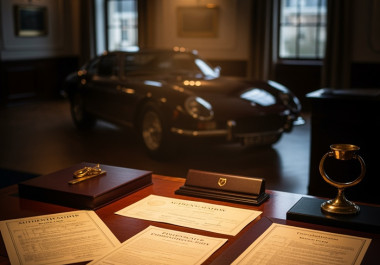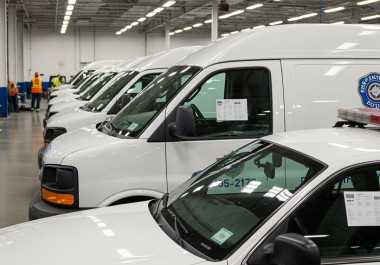It’s the modern car buyer's dilemma: the perfect motor appears on the screen, but it's 200 miles away. The head screams 'risky,' but the heart whispers 'bargain.' That moment of hesitation, staring at photos and wondering whether to take a punt, is what separates a savvy buyer from someone who ends up with a horror story.
This is the big question in the auction scene: Is it ever smart to buy a car at auction online without seeing it in the flesh? Some will say it’s madness; others will say it’s the only way they buy. The truth, as with most things in the motor trade, is somewhere in the middle. It all comes down to knowing what to look at and what to look out for.
First, Why Do People Even Take the Gamble?
It’s easy to see the appeal of bidding from the sofa. Life’s busy. Not everyone can sacrifice a Tuesday afternoon to drive from Manchester to Birmingham for a viewing, especially when running a business. If an auction house provides a 360-degree photo gallery and a detailed report, it can feel like a safe enough bet.
Then there’s the thrill of the chase. Auctions can throw up all sorts of unique vehicles, a 2015 Ford Transit Custom with factory-fitted shelving, a Category S repaired Audi TT with desirable options, or a classic MGB GT that’s been tucked away for years. Sometimes these pop up with only 24 hours to go, leaving no time for a visit. Seeing a long-sought-after car with a good description makes the fear of missing out a powerful motivator.
And let’s be honest, the whole game has moved online. It’s convenient, fast, and has opened up the market to people who would never have set foot in a traditional auction hall.
So, When Can Buying Unseen Be a Smart Move?
It’s not always a blind gamble based on hope. There are specific situations where bidding on an unseen car is a perfectly sensible, calculated decision.
-
When the Report is Top-Notch: A reputable auction house knows its description is its handshake. A detailed, honest condition report that points out specifics like "tyre tread depths all above 4mm," "no warning lights on dash," or "air-con blows cold" inspires confidence. Look for plenty of clear photos showing close-ups of any damage and maybe even a short video of the engine running from cold.
-
When the Model is a Known Quantity: For a specialist or an enthusiast, the common faults of certain cars are second nature. Knowing to check for timing chain noise on a 2012 BMW 320d, or to look for rust on the rear arches of a Ford Fiesta Mk6, allows for reading between the lines of a listing and asking targeted questions.
-
When the Price Creates a Safety Net: Sometimes, a car is just so cheap that it’s worth the risk. If a motor has a few cosmetic issues listed, like a scuffed alloy or a car park ding, but the price is trending 25% below the typical forecourt price, there’s a built-in buffer to fix any little surprises. This is the bread and butter of the trade, buying with enough margin to sort out problems and still turn a profit.
The Flip Side: What Can Go Wrong When Bidding Blind
Now for the other side of the coin, because no matter how good the photos are, they can’t reveal everything.
The biggest risk is simple: a picture can’t convey the smell of a damp interior from a leaky seal, the sound of a faint rattle from a worn-out suspension bush, or the feel of a slight clutch judder when pulling away. A "minor scratch" in a report can turn out to be a deep gouge that needs a bodyshop to sort out, costing £300. Tyres that look fine in a photo could have only 2mm of tread left, meaning a £400 bill is just around the corner. A lot of trust is placed in the seller’s description.
This can lead to overpaying. If the car isn't in the expected condition, the buyer could be facing a hefty, unbudgeted repair bill. That supposed bargain can quickly turn into a money pit. And that’s without mentioning the sheer stress of waiting for a car to be delivered, not knowing if it’s a gem or a dud.
Your Game Plan for Bidding Unseen
Knowing the risks, how do you stack the odds in your favour? It’s about having a clear strategy and using your head, not just your heart.
-
Read Everything Twice: That condition report is a buyer's best friend. Don't just skim it. Read every word. If it says "slight noise from gearbox on overrun," assume it might need a £1,000 rebuild and adjust your maximum bid accordingly. If key information like the MOT expiry date or the number of former keepers is missing, pick up the phone.
-
Ask for More: Don’t be shy. If the photos don’t show a particular area of concern, like the sills or under the boot carpet, ask the auction house for another picture. The good ones will be happy to help because it protects them, too.
-
Set a Strict Limit: This is the golden rule. It’s easy to get carried away in the heat of the moment. Decide on an absolute maximum bid before the auction starts and stick to it. Remember to add the buyer’s premium (often 5-10% + VAT) and transport costs to your total.
-
Trust Your Gut: If something feels off, it probably is. If the description is vague, the photos are blurry, or the auction house is hard to get hold of, it’s often best to just walk away. There will always be another car.
The Bottom Line: Is It Worth the Risk?
Buying a car at auction without seeing it first isn't for the faint-hearted, but it doesn't have to be a shot in the dark. The whole industry has become much more transparent, and reputable sites know their reputation is on the line with every listing.
The key is to focus on the quality of the information provided. If the report is thorough, the pictures are clear, and the car is a familiar model, a bargain can absolutely be had. For those ready to get started, you can register here and start browsing the latest listings. Just remember to do the homework, set the limits, and trust your instincts. The next hidden gem could be just a click away.




